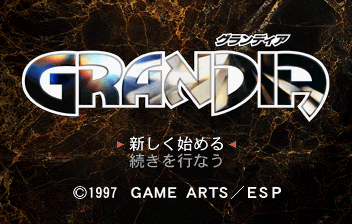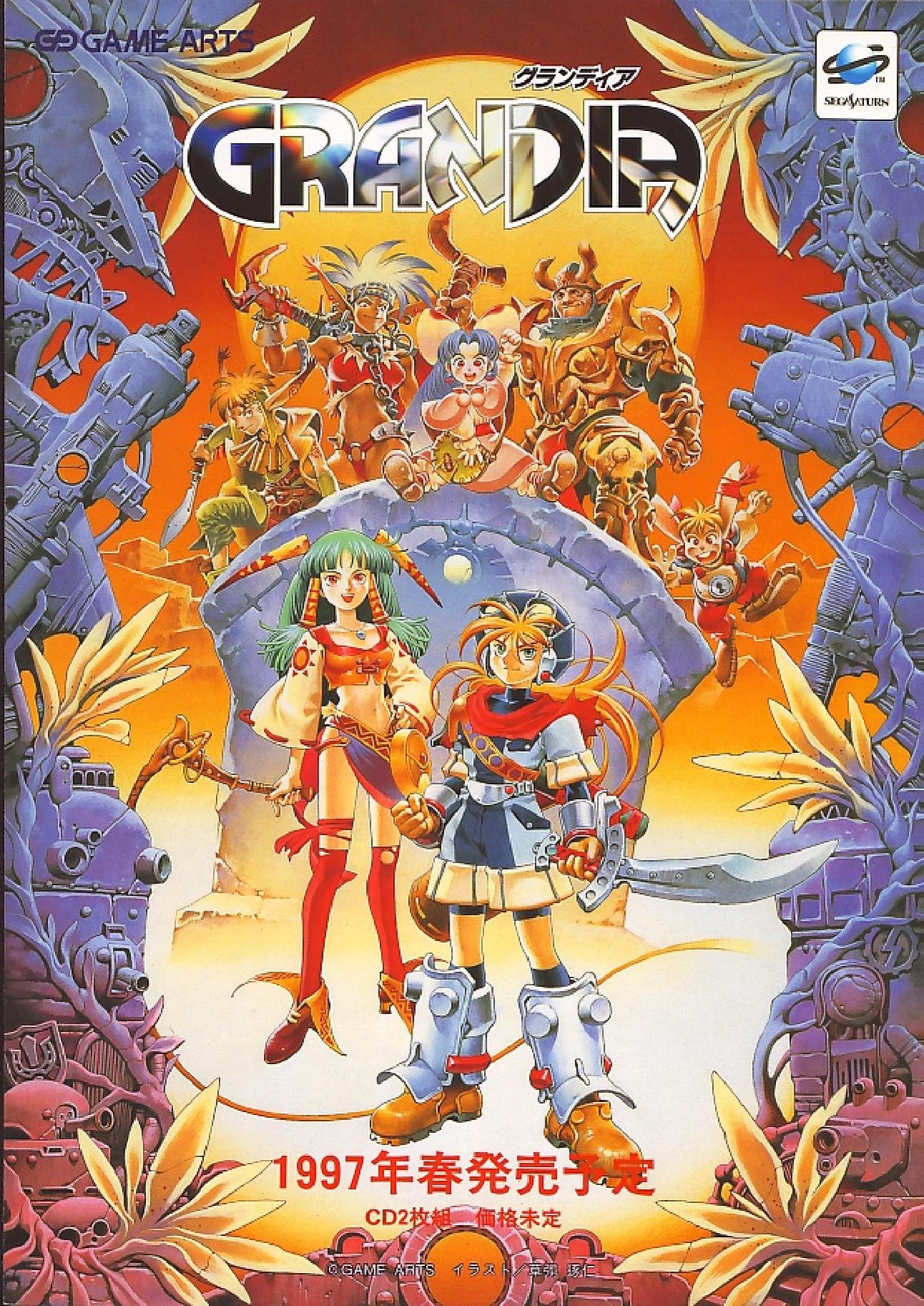Grandia
From Sega Retro
| Grandia | |||||||||||||||
|---|---|---|---|---|---|---|---|---|---|---|---|---|---|---|---|
| System(s): Sega Saturn | |||||||||||||||
| Publisher: Game Arts, Entertainment Software Publishing | |||||||||||||||
| Developer: Game Arts | |||||||||||||||
| Sound driver: SCSP (1/1Track) | |||||||||||||||
| Genre: RPG[1] | |||||||||||||||
| Number of players: 1 | |||||||||||||||
| |||||||||||||||
|
This short article is in need of work. You can help Sega Retro by adding to it.
Grandia (グランディア) is a Sega Saturn RPG released in Japan and later brought overseas on the PlayStation. It is the first entry in Game Arts's popular Grandia series of RPGs. It was followed by Grandia II. Because of it's lighthearted and colorful tone, the game is very similar to Lunar, another Game Arts franchise.
The game was once set for release on the Sega Mega-CD. A US Saturn version was also at one point planned for the first quarter of 1998[4].
Contents
Story
In a humble port town, Justin is playing games with his friends, while rumors are circulating that a new continent has been found. Meanwhile, the Garlyle forces, the main militia of the game's primary villains, are hunting for information regarding power sealed inside of the ancient ruins of past civilizations. Justin, along with his friend Sue, dream of going on the same adventures that Justin's late father undertook before him. Managing to get an entry pass to the adventurer's society, he is eventually led on a tour of the ancient ruins near his hometown. Inside, he opens a door with the help of a spirit stone and discovers that the legends of these cities may be a reality. But when the Garlyle forces go after him, they learn of what he has found and from there the adventure begins.
Gameplay
Grandia was distinct from many JRPGs of its time, in that players can see the enemies on the world map. Whether or not an enemy is caught from behind or vice versa, can trigger a first-strike surprise battle in a separate screen. The battle mode is also semi-tactical; players do not move through a grid but a series of several spots in terms of evasion or reaching enemies. Attacks are performed as a meter goes up, and this is the same for enemies, meaning whoever is first in line will be next to attack. Certain skills require more time to be process and even recover after use. Players can level up individual weapons, for which each character is capable of using a different set. Magic is also leveled up, like weapons, through use, though they must be obtained using mana eggs. The field also allows people to interact with objects, which either results in something as pointless as causing a tool to rattle, or triggering a door, bridge, and such for another player to travel.
History
Legacy
The original Saturn version was a hit at the time of its release and won a Japan Game of the Year award. It sold nearly a million copies, and alongside Virtua Fighter 2, is one of the system's best selling titles. It has since become one of the system's most beloved titles. In 2015, Dengeki Online, a major video game publication in Japan, did an article recollecting the Saturn's history. In it, contributors were asked to name their 20 all-time favorite Saturn games, with Grandia receiving a nearly unanimous recommendation[5]. The Saturn version never saw a release outside of Japan. However, the PlayStation port, released in 1999, was published in both US and PAL territories. In Japan, although the PlayStation port entered the greatest hits line, it did not perform as well in sales numbers as its Saturn counterpart. In the west, Grandia was looked at as a cult classic but did not become the phenomenal hit that many english publications were expecting.
Many gamers in the west view Saturn's definitive JRPG as either Shining Force III, Dragon Force, or Panzer Dragoon Saga. Neither of these became a major success in western territories, and are sought after because of their limited production. Saturn was being discontinued in the US when Grandia debuted in Japan, where it continued to be produced until 2001. During the 1997-1998 period, Saturn's main competitor for an RPG blockbuster was PlayStation's Final Fantasy VII by SquareSoft (now Square-Enix). Although Saturn could never rival the sales of Sony's console and it's highlights, the Japanese market's acceptance of Saturn helped usher the lighthearted Grandia into commercial success. In this region, it was viewed as the system's answer to Final Fantasy VII (as some US outlets even suggested) though the two are quite different in style.
The PS version features some downgraded graphical effects, mostly due to 2D layering. For example, the Saturn version has a higher definition battle background.
The Saturn version also had an expansion disc called Grandia: Digital Museum, which allowed players to use their save files from the original game with a variety of bonus dungeons and unlockables.
Versions
Fan Translations
A fan translation in Korean exists for the Saturn version and is attributed to a South Korean ROM hacker known as CyZero. Most of the text is translated to Korean except the battle icons and the voices, which remain in Japanese as in the original.
Magazine articles
- Main article: Grandia/Magazine articles.
Promotional material
Physical scans
| Sega Retro Average | |||||||||||||||||||||||||||||||||||||||||||||||||||||||||||||||||||||||||||||||
|---|---|---|---|---|---|---|---|---|---|---|---|---|---|---|---|---|---|---|---|---|---|---|---|---|---|---|---|---|---|---|---|---|---|---|---|---|---|---|---|---|---|---|---|---|---|---|---|---|---|---|---|---|---|---|---|---|---|---|---|---|---|---|---|---|---|---|---|---|---|---|---|---|---|---|---|---|---|---|---|
|
| 90 | |
|---|---|
| Based on 15 reviews | |
Technical information
ROM dump status
| System | Hash | Size | Build Date | Source | Comments | |||||||||
|---|---|---|---|---|---|---|---|---|---|---|---|---|---|---|
| ✔ |
|
620,617,536 | 1997-11-08 | CD-ROM (JP) | T-4507G, T-4513G (Disc 1) V1.002 | |||||||||
| ✔ |
|
587,226,192 | 1997-11-17 | CD-ROM (JP) | T-4507G, T-4513G (Disc 2) V1.004 |
References
- ↑ 1.0 1.1 https://sega.jp/fb/segahard/ss/soft_licensee3.html (Wayback Machine: 2019-07-28 12:30)
- ↑ Sega Saturn Magazine, "1997-38 (1997-11-07)" (JP; 1997-10-24), page 107
- ↑ 3.0 3.1 Sega Saturn Magazine, "1998-30 (1998-10-23)" (JP; 1998-10-09), page 180
- ↑ Tips & Tricks, "xxxx xxxx" (US; xxxx-xx-xx), page 38
- ↑ Introduction to Saturn's masterpieces: Editor/Writer recommendations
- ↑ Joypad, "Février 1998" (FR; 1998-xx-xx), page 70-72 (70)
- ↑ Sega Magazin, "April 1998" (DE; 1998-03-11), page 28-30 (28)
- ↑ 8.0 8.1 Sega Saturn Magazine, "April 1998" (UK; 1998-03-11), page 66
- ↑ Sega Saturn Magazine, "1997-45 (1997-12-26)" (JP; 1997-12-12), page 217 (219)
- ↑ Sega Saturn Magazine (readers), "Final data" (JP; 2000-03), page 8 (10)
- ↑ Consoles +, "Février 1998" (FR; 1998-0x-xx), page 94
- ↑ Famitsu, "1997-12-26" (JP; 1997-12-12), page 1
- ↑ GameFan, "Volume 6, Issue 4: April 1998" (US; 1998-xx-xx), page 14
- ↑ Joypad, "Février 1998" (FR; 1998-xx-xx), page 70
- ↑ Mega Console, "Febbraio 1998" (IT; 1998-xx-xx), page 66
- ↑ Mega Force, "Avril/Mai/Juin 1998" (FR; 1998-0x-xx), page 44
- ↑ Next Generation, "April 1998" (US; 1998-03-17), page 102
- ↑ neXt Level, "März 1998" (DE; 1998-02-30), page 68
- ↑ Saturn Fan, "1997 No. 24" (JP; 1997-12-12), page 185
- ↑ Saturn Fan, "1998 No. 3" (JP; 1998-01-30), page 73
- ↑ Sega Magazin, "April 1998" (DE; 1998-03-11), page 28
- ↑ SuperGamePower, "Março 1998" (BR; 1998-xx-xx), page 21
- ↑ Sega Saturn Magazine, "1997-45 (1997-12-26)" (JP; 1997-12-12), page 219
- ↑ Sega Saturn Magazine, "Readers rating final data" (JP; 2000-03), page 10
| Grandia | |
|---|---|
|
Main page | Comparisons | Hidden content | Magazine articles | Reception | Technical information | Bootlegs
Demos: Grandia: Prelude (1997) | |
| Grandia series | |
|---|---|
| Grandia (1997) | Grandia Digital Museum (1998) | |
| Grandia II (2000) | |
- 1 player games
- JP Saturn games
- Saturn games
- 1997 Saturn games
- All 1997 games
- Saturn RPGs
- All RPGs
- All games
- Stubs
- Old-style rating (consolesplus)
- External rating reference
- Rating without PDF source
- Old-style rating (famitsu)
- Old-style rating (gamefan)
- Old-style rating (gamesmaster)
- Old-style rating (joypad)
- Old-style rating (saturnfan)
- Old-style rating (segamagazin)
- Old-style rating (ssm)
- Old-style rating (ssmjp)
- Old-style rating (ssmjp r)
- Old-style rating (weeklytv)
- Update ratings template
- 13 old ratings
- Missing ROM hashes
- Old technical information
- Grandia
- Grandia (franchise)
- Unreleased Mega-CD games













